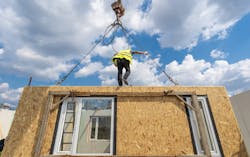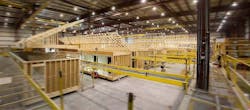Understanding the Differences Between Modular and Site-Built Construction
Modular building has been gaining popularity in recent years as a more efficient and cost-effective alternative to traditional site-built construction, but where does that efficiency come into play in the building process?
Modular construction procedures can accelerate project timelines by 20%-50%, according to a report by McKinsey & Company, and part of that speed comes from working in a controlled environment. While both methods of construction aim to create functional and design-forward structures, onsite and modular builders take vastly different approaches to achieve that end goal.
In a recent education session at the 2023 International Builders' Show, Ken Semler, president and founder of Impresa Modular, discussed the key differences between modular building and site-built construction.
What’s Modular and What’s Site-Built?
One of the most significant differences between modular production and site-built development is the method of hands-on construction. While modular building involves the fabrication of individual modules or sections of a building in a factory, which are then transported to the building site for assembly, site-built construction requires a crew to assemble a home on a construction site, piece by piece.
As Semler explains, "in modular building, the majority of the work is done in the factory, where the controlled environment allows for a higher level of quality control and faster construction times. This leads to lower labor costs and less waste."
A traditional site-built home takes an average of 7.6 months to construct from start to completion, but a modular home can be delivered—with interior finishes and landscaping—in an average time frame of 8 weeks, Semler says. When it arrives onsite, a modular home manufactured by Impresa is already 80-90% complete, meaning fewer delays from inspections and bad weather and fewer trade partners needed to get the job done.
Semler adds, "with site-built construction, weather, site conditions, and other factors can significantly impact the timeline and budget of a project. With modular building, the controlled environment means that these variables can be minimized, leading to a more predictable and efficient construction process."
The Potential Benefits of Modular
In the midst of a rampant labor shortage, the introduction of a new building process can also create a pathway for new job opportunities, especially as demand for modular construction rises.
Another advantage of modular building is the ability to create custom designs with greater ease. "Modular building allows for greater flexibility in design because it’s easier to replicate a design in a factory environment than on a construction site," Semler says. "This means that architects and designers can create unique designs that can be replicated on multiple projects with greater consistency and accuracy."
Because modular sections are manufactured individually, homes created by Impresa offer a nearly endless array of design opportunities. Each section is simply pieced together using large cranes in a process similar to building with Legos, Semler says.
In addition to its design capabilities, Semler emphasizes the sustainability of modular building. "Modular construction uses fewer resources and generates less waste than traditional site-built construction," he says. "In addition, modular buildings can be designed to be more energy-efficient, which can lead to significant cost savings for the owner over the life of the building."
With a construction process characterized by speed, precision, and sustainability, the modular housing sector is becoming a more popular choice among homebuyers looking for new construction. As a result, the market value for modular construction in new real-estate construction alone is expected to reach $130 billion in Europe and the United States by 2030. And according to Semler, that fast-track for the industry is already underway: "Modular construction is not just the future of construction; it is the present."

